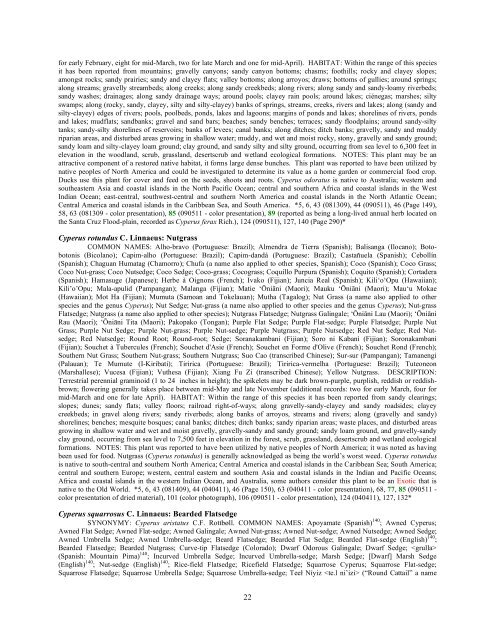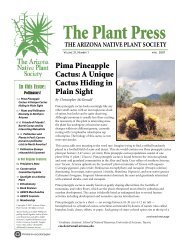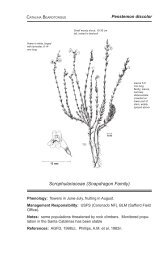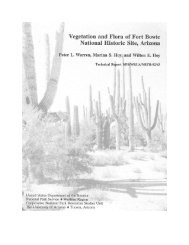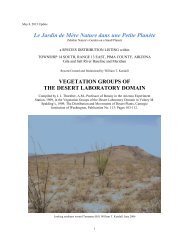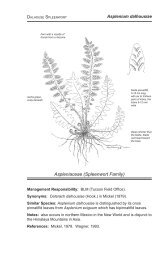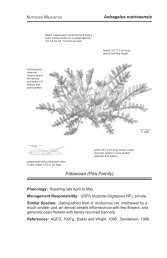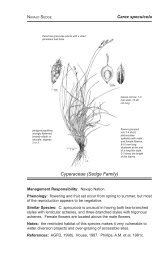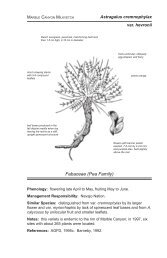T14S.R13E Pima County.AZ 050813 - Arizona Native Plant Society
T14S.R13E Pima County.AZ 050813 - Arizona Native Plant Society
T14S.R13E Pima County.AZ 050813 - Arizona Native Plant Society
You also want an ePaper? Increase the reach of your titles
YUMPU automatically turns print PDFs into web optimized ePapers that Google loves.
for early February, eight for mid-March, two for late March and one for mid-April). HABITAT: Within the range of this speciesit has been reported from mountains; gravelly canyons; sandy canyon bottoms; chasms; foothills; rocky and clayey slopes;amongst rocks; sandy prairies; sandy and clayey flats; valley bottoms; along arroyos; draws; bottoms of gullies; around springs;along streams; gravelly streambeds; along creeks; along sandy creekbeds; along rivers; along sandy and sandy-loamy riverbeds;sandy washes; drainages; along sandy drainage ways; around pools; clayey rain pools; around lakes; ciénegas; marshes; siltyswamps; along (rocky, sandy, clayey, silty and silty-clayey) banks of springs, streams, creeks, rivers and lakes; along (sandy andsilty-clayey) edges of rivers; pools, poolbeds, ponds, lakes and lagoons; margins of ponds and lakes; shorelines of rivers, pondsand lakes; mudflats; sandbanks; gravel and sand bars; beaches; sandy benches; terraces; sandy floodplains; around sandy-siltytanks; sandy-silty shorelines of reservoirs; banks of levees; canal banks; along ditches; ditch banks; gravelly, sandy and muddyriparian areas, and disturbed areas growing in shallow water; muddy, and wet and moist rocky, stony, gravelly and sandy ground;sandy loam and silty-clayey loam ground; clay ground, and sandy silty and silty ground, occurring from sea level to 6,300 feet inelevation in the woodland, scrub, grassland, desertscrub and wetland ecological formations. NOTES: This plant may be anattractive component of a restored native habitat, it forms large dense bunches. This plant was reported to have been utilized bynative peoples of North America and could be investigated to determine its value as a home garden or commercial food crop.Ducks use this plant for cover and feed on the seeds, shoots and roots. Cyperus odoratus is native to Australia; western andsoutheastern Asia and coastal islands in the North Pacific Ocean; central and southern Africa and coastal islands in the WestIndian Ocean; east-central, southwest-central and southern North America and coastal islands in the North Atlantic Ocean;Central America and coastal islands in the Caribbean Sea, and South America. *5, 6, 43 (081309), 44 (090511), 46 (Page 149),58, 63 (081309 - color presentation), 85 (090511 - color presentation), 89 (reported as being a long-lived annual herb located onthe Santa Cruz Flood-plain, recorded as Cyperus ferax Rich.), 124 (090511), 127, 140 (Page 290)*Cyperus rotundus C. Linnaeus: NutgrassCOMMON NAMES: Alho-bravo (Portuguese: Brazil); Almendra de Tierra (Spanish); Balisanga (Ilocano); Botobotonis(Bicolano); Capim-alho (Portuguese: Brazil); Capim-dandá (Portuguese: Brazil); Castañuela (Spanish); Cebollín(Spanish); Chaguan Humatag (Chamorro); Chufa (a name also applied to other species, Spanish); Coco (Spanish); Coco Grass;Coco Nut-grass; Coco Nutsedge; Coco Sedge; Coco-grass; Cocograss; Coquillo Purpura (Spanish); Coquito (Spanish); Cortadera(Spanish); Hamasuge (Japanese); Herbe à Oignons (French); Ivako (Fijian); Juncia Real (Spanish); Kili‘o‘Opu (Hawaiian);Kili’o’Opu; Mala-apulid (Pampangan); Malanga (Fijian); Matie ‘Ōniāni (Maori); Mauku ‘Ōniāni (Maori); Mau‘u Mokae(Hawaiian); Mot Ha (Fijian); Mumuta (Samoan and Tokelauan); Mutha (Tagalog); Nut Grass (a name also applied to otherspecies and the genus Cyperus); Nut Sedge; Nut-grass (a name also applied to other species and the genus Cyperus); Nut-grassFlatsedge; Nutgrass (a name also applied to other species); Nutgrass Flatsedge; Nutgrass Galingale; ‘Ōniāni Lau (Maori); ‘ŌniāniRau (Maori); ‘Ōniāni Tita (Maori); Pakopako (Tongan); Purple Flat Sedge; Purple Flat-sedge; Purple Flatsedge; Purple NutGrass; Purple Nut Sedge; Purple Nut-grass; Purple Nut-sedge; Purple Nutgrass; Purple Nutsedge; Red Nut Sedge; Red Nutsedge;Red Nutsedge; Round Root; Round-root; Sedge; Soranakambani (Fijian); Soro ni Kabani (Fijian); Soronakambani(Fijian); Souchet à Tubercules (French); Souchet d'Asie (French); Souchet en Forme d'Olive (French); Souchet Rond (French);Southern Nut Grass; Southern Nut-grass; Southern Nutgrass; Suo Cao (transcribed Chinese); Sur-sur (Pampangan); Tamanengi(Palauan); Te Mumute (I-Kiribati); Tiririca (Portuguese: Brazil); Tiririca-vermelha (Portuguese: Brazil); Tuteoneon(Marshallese); Vucesa (Fijian); Vuthesa (Fijian); Xiang Fu Zi (transcribed Chinese); Yellow Nutgrass. DESCRIPTION:Terrestrial perennial graminoid (1 to 24 inches in height); the spikelets may be dark brown-purple, purplish, reddish or reddishbrown;flowering generally takes place between mid-May and late November (additional records: two for early March, four formid-March and one for late April). HABITAT: Within the range of this species it has been reported from sandy clearings;slopes; dunes; sandy flats; valley floors; railroad right-of-ways; along gravelly-sandy-clayey and sandy roadsides; clayeycreekbeds; in gravel along rivers; sandy riverbeds; along banks of arroyos, streams and rivers; along (gravelly and sandy)shorelines; benches; mesquite bosques; canal banks; ditches; ditch banks; sandy riparian areas; waste places, and disturbed areasgrowing in shallow water and wet and moist gravelly, gravelly-sandy and sandy ground; sandy loam ground, and gravelly-sandyclay ground, occurring from sea level to 7,500 feet in elevation in the forest, scrub, grassland, desertscrub and wetland ecologicalformations. NOTES: This plant was reported to have been utilized by native peoples of North America; it was noted as havingbeen used for food. Nutgrass (Cyperus rotundus) is generally acknowledged as being the world’s worst weed. Cyperus rotundusis native to south-central and southern North America; Central America and coastal islands in the Caribbean Sea; South America;central and southern Europe; western, central eastern and southern Asia and coastal islands in the Indian and Pacific Oceans;Africa and coastal islands in the western Indian Ocean, and Australia, some authors consider this plant to be an Exotic that isnative to the Old World. *5, 6, 43 (081409), 44 (040411), 46 (Page 150), 63 (040411 - color presentation), 68, 77, 85 (090511 -color presentation of dried material), 101 (color photograph), 106 (090511 - color presentation), 124 (040411), 127, 132*Cyperus squarrosus C. Linnaeus: Bearded FlatsedgeSYNONYMY: Cyperus aristatus C.F. Rottbøll. COMMON NAMES: Apoyamate (Spanish) 140 ; Awned Cyperus;Awned Flat Sedge; Awned Flat-sedge; Awned Galingale; Awned Nut-grass; Awned Nut-sedge; Awned Nutsedge; Awned Sedge;Awned Umbrella Sedge; Awned Umbrella-sedge; Beard Flatsedge; Bearded Flat Sedge; Bearded Flat-sedge (English) 140 ;Bearded Flatsedge; Bearded Nutgrass; Curve-tip Flatsedge (Colorado); Dwarf Odorous Galingale; Dwarf Sedge; (Spanish: Mountain <strong>Pima</strong>) 140 ; Incurved Umbrella Sedge; Incurved Umbrella-sedge; Marsh Sedge; [Dwarf] Marsh Sedge(English) 140 ; Nut-sedge (English) 140 ; Rice-field Flatsedge; Ricefield Flatsedge; Squarrose Cyperus; Squarrose Flat-sedge;Squarrose Flatsedge; Squarrose Umbrella Sedge; Squarrose Umbrella-sedge; Teeł Níyiz (“Round Cattail” a name22


